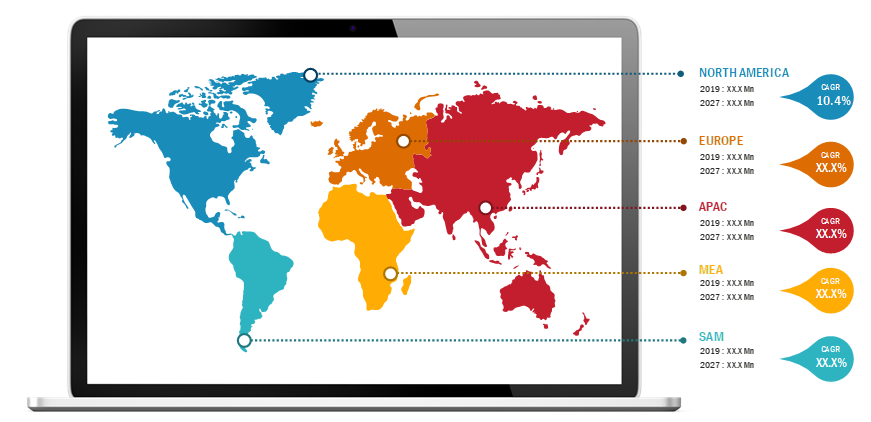$4450
$3560
The practice management systems market size is expected to reach US$ 36.33 billion by 2031 from US$ 19.65 billion in 2024. The market is anticipated to register a CAGR of 9.3% during 2025–2031.
Practice Management Systems Market Analysis
The practice management systems market forecast indicates growth, owing to large-scale digitalization of healthcare systems, efficient resource utilization and cost savings, and increasing regulatory and reimbursement compliance requirements. The market expansion is facilitated by the compatibility with telehealth and remote monitoring systems, AI-powered data analytics, and government incentives for using digital health. Additionally, shifting to cloud and integrated PMS solutions that simplify patient billing and insurance claim handling boosts the market growth.
Practice Management Systems Market Overview
Practice management systems (PMS) are necessary software that simplifies and automates the administrative and operational activities of healthcare practices. The system makes efficient management of scheduling, billing, patient records, insurance claims, and workflow coordination in different medical and allied health environments easier. By increasing efficiency, cutting down on paperwork, and facilitating patient engagement, PMS solutions allow healthcare providers to give more time to clinical care while ensuring compliance with regulations and financial stability.
Customize Research To Suit Your Requirement
We can optimize and tailor the analysis and scope which is unmet through our standard offerings. This flexibility will help you gain the exact information needed for your business planning and decision making.
Practice Management Systems Market: Strategic Insights

Market Size Value in US$ 16,795.49 million in 2022 Market Size Value by US$ 33,065.11 million by 2030 Growth rate CAGR of 8.84% from 2022 to 2030 Forecast Period 2022-2030 Base Year 2022

Naveen
Have a question?
Naveen will walk you through a 15-minute call to present the report’s content and answer all queries if you have any.
 Speak to Analyst
Practice Management Systems Market Drivers and Opportunities
Speak to Analyst
Practice Management Systems Market Drivers and Opportunities
Customize Research To Suit Your Requirement
We can optimize and tailor the analysis and scope which is unmet through our standard offerings. This flexibility will help you gain the exact information needed for your business planning and decision making.
Practice Management Systems Market: Strategic Insights

| Market Size Value in | US$ 16,795.49 million in 2022 |
| Market Size Value by | US$ 33,065.11 million by 2030 |
| Growth rate | CAGR of 8.84% from 2022 to 2030 |
| Forecast Period | 2022-2030 |
| Base Year | 2022 |

Naveen
Have a question?
Naveen will walk you through a 15-minute call to present the report’s content and answer all queries if you have any.
 Speak to Analyst
Speak to Analyst
Market Drivers:
Rising Demand for Operational Efficiency in Healthcare Delivery:
Healthcare organizations are seeing a mass inflow of patients, which complicated processes and cost hikes are major challenges.Growing Telemedicine and Virtual Care Models:
The global shift to digital healthcare has significantly increased the scope of PMS.Increasing Government Initiatives and Regulatory Mandates Driving Digital Health Adoption:
PMS are among a variety of healthcare IT solutions whose widespread implementation is actively supported by governments worldwide.
Market Opportunities:
Expansion in Emerging Markets with Growing Private Healthcare Sectors:
Emerging markets such as India, China, and Brazil are witnessing an increased adoption of practice management systems due to expanding private healthcare sectors and rising healthcare IT investments.Integration with Electronic Health Records (EHR) and Analytics Platforms:
The integration of PMS with EHR systems and sophisticated analytics results in seamless data management and on-the-spot insights.Demand for AI-Driven Automation and Workflow Optimization:
The trend for digitalization in healthcare and intelligent healthcare infrastructure is the main driver of the demand for AI-powered PMS solutions.
Practice Management Systems Market Report Segmentation Analysis
The practice management systems market share is analyzed across various segments to provide a clearer understanding of its structure, growth potential, and emerging trends. Below is the standard segmentation approach used in most industry reports:
By Product:
Integrated Practice Management Systems:
Integrated practice management systems (IPMS) are the combination of three functionalities: administrative, clinical, and financial, which are brought together seamlessly to enable the providers of healthcare to streamline their operations, upgrade patient care, and make revenue cycle management efficient.Standalone Practice Management Systems:
Standalone practice management systems (PMS) are tailored to the specific needs of the practice management systems market, offering core administrative functions—such as scheduling, billing, and patient registration—without extending into clinical systems like Electronic Health Records (EHRs).
By Component:
Software:
The software segment of practice management systems (PMS) market is the base that supports the entire market ecosystem. A range of digital solutions help healthcare practices automate and simplify their administrative and financial operations.Services:
The services segment is vital in supporting the successful implementation, optimization, and ongoing operation of PMS software solutions.
By Delivery Mode:
Web-based Practice Management Systems:
Web-based PMS is the most mature and prevalent application implemented in the practice management field to manage the workflow of the different healthcare teams easily and efficiently.Cloud-based Practice Management Systems:
Healthcare providers can use cloud-based PMS to have a scalable and adaptable infrastructure.On-premise Practice Management Systems:
On-premise PMS solutions enable healthcare providers to closely monitor patient flow, financial cycles, and overall practice performance through comprehensive tracking and management features.
By End-User:
- Hospitals and Clinics
- Physician’s Office
- Insurance Companies
- Others
Each sector has specific practice management systems requirements. It influences data management and analysis.
By Geography:
- North America
- Europe
- Asia Pacific
- South & Central America
- Middle East & Africa
The practice management systems market in Asia Pacific is expected to witness the fastest growth during the forecast period, driven by rapid healthcare digitalization in countries such as China, India, and Japan.
Practice Management Systems Market Report ScopePractice Management Systems Market Share Analysis by Geography
Asia Pacific is expected to grow fastest in the coming years. Emerging markets in South & Central America, the Middle East, and Africa also have many untapped opportunities for practice management systems providers to expand.
The practice management systems market shows a different growth trajectory in each region due to factors such as healthcare infrastructure, regulatory environment, digital health adoption, and government initiatives. Below is a summary of market share and trends by region:
1. North America
Market Share:
Holds the largest market share due to advanced healthcare infrastructure and early digital adoption.Key Drivers:
- Widespread EHR/EMR integration
- Regulatory compliance (e.g., HIPAA, MACRA)
- High demand for Revenue Cycle Management (RCM) tools
Trends:
Shift toward cloud-based PMS and telehealth integration to streamline administrative workflows and remote care delivery.
2. Europe
Market Share:
Public healthcare systems and strict data governance policies drive a significant share.Key Drivers:
- GDPR-compliant software demand
- National Health Service (NHS) digitization projects
- Growing need for efficiency in multi-specialty practices
Trends:
Increasing use of interoperable PMS platforms to support cross-border health data exchange and unified care delivery.
3. Asia Pacific
Market Share:
Fastest-growing region owing to rapid healthcare digitization and expanding medical tourism.Key Drivers:
- Government-supported health IT initiatives
- Surge in private healthcare providers
- Rising patient volumes and urban healthcare demand
Trends:
Adoption of AI-driven PMS for appointment scheduling, billing automation, and language localization features.
4. South and Central America
Market Share:
Emerging market with growing digital health adoption.Key Drivers:
- Public-private health partnerships
- Need for administrative efficiency in underfunded systems
- Expansion of private clinics and specialist centers
Trends:
Cloud-based, cost-effective PMS solutions are gaining traction, especially among small-to-medium healthcare providers.
5. Middle East and Africa
Market Share:
Developing market with strong growth potential due to rising healthcare investments.Key Drivers:
- National e-health strategies
- Healthcare infrastructure expansion
- Rising demand for medical practice automation
Trends:
Implementation of PMS in integrated care models, including primary, specialty, and diagnostic services—often as part of broader health information systems
Practice Management Systems Market Players Density: Understanding Its Impact on Business Dynamics
High Market Density and Competition
Competition is intensifying due to the presence of major vendors such as GE HealthCare Technologies Inc., Athenahealth Inc., and WRS Health. Regional and niche players like MEDITECH (North America) also contribute to the crowded market landscape.
This competitive environment pushes vendors to differentiate through:
- Seamless integration with electronic health records (EHR) and telehealth platforms
- Scalable, cloud-based PMS solutions tailored to small practices and large healthcare networks
- AI-enabled automation for appointment scheduling, billing, and coding accuracy
- Interoperability with third-party systems, including labs, pharmacies, and insurance providers
Opportunities and Strategic Moves
- Partner with healthcare providers and public health systems to support digital transformation and workflow optimization
- Incorporate AI/ML for revenue cycle management, patient engagement, and operational forecasting.
Major Companies operating in the Practice Management Systems Market are:
- GE HealthCare Technologies Inc, United States
- Athenahealth Inc., United States
- WRS Health, United States
- Veradigm Inc., United States
- Greenway Health LLC, United States
- McKesson Corp, United States
- NextGen Healthcare Inc., United States
- MEDITECH, United States
- CERTIFY Health, United States
- eClinicalWorks LLC, United States
Disclaimer: The companies listed above are not ranked in any particular order.
Other companies analysed during the course of research:
- OmniMD Henry Schein, Inc.
- AdvantEdge Healthcare Solutions
- Cerner Corporation (Oracle)
- Epic Systems Corporation
- Accumedic Computer Systems, Inc.
- NXGN Management, LLC
- CoreCloud
- Kareo, Inc.
- Practice Fusion, Inc.
- AdvancedMD, Inc.
- DrChrono, Inc.
- CollaborateMD Inc.
- OfficeAlly Inc.
- PracticeSuite Inc.
Practice Management Systems Market News and Recent Developments
eClinicalWorks, the largest ambulatory cloud EHR, announced that South Lake Pediatrics, a prominent physician-owned pediatrics practice in Minnesota
eClinicalWorks, the largest ambulatory cloud EHR, announced that South Lake Pediatrics, a prominent physician-owned pediatrics practice in Minnesota, is leveraging Sunoh.ai, an AI-powered medical scribe, to enhance clinical documentation efficiency.GE HealthCare (Nasdaq: GEHC) has topped the US Food and Drug Administration (FDA) list of AI-enabled medical device authorizations for the fourth year.
GE HealthCare (Nasdaq: GEHC) has topped a US Food and Drug Administration (FDA) list of AI-enabled medical device authorizations for the fourth year in a row, with 100 listed authorizations to date in the US. This milestone reflects GE HealthCare’s continued investment and development, focusing on developing AI solutions to advance precision care by enhancing medical devices across the care journey. Smart devices, software, and cloud-based solutions, which are central to GE HealthCare’s precision care strategy, help enhance patient outcomes, improve care teams' daily work, and boost healthcare professionals' efficiency.
Practice Management Systems Market Report Coverage and Deliverables
The "Practice Management Systems Market Size and Forecast (2021–2031)" report provides a detailed analysis of the market covering below areas:
- Practice Management Systems Market size and forecast at global, regional, and country levels for all the key market segments covered under the scope
- Practice Management Systems Market trends, as well as market dynamics such as drivers, restraints, and key opportunities
- Detailed PEST and SWOT analysis
- Practice Management Systems Market analysis covering key market trends, global and regional framework, major players, regulations, and recent market developments
- Industry landscape and competition analysis covering market concentration, heat map analysis, prominent players, and recent developments in the Practice Management Systems Market
- Detailed company profiles

Report Coverage
Revenue forecast, Company Analysis, Industry landscape, Growth factors, and Trends

Segment Covered
Product, Component, Delivery Mode, Application, End User, and Geography

Regional Scope
North America, Europe, Asia Pacific, Middle East & Africa, South & Central America

Country Scope
This text is related
to country scope.
Frequently Asked Questions
As of 2025: 1. North America: Leads the market with an estimated share of 42.9%. This large share is driven by strong adoption among physicians and supported by regulatory initiatives promoting digital transformation in clinics and hospitals.2. Europe: Holds a 25.4% market share, driven primarily by mandatory regulatory compliance, increasing digitization, and government-backed e-health strategies aimed at accelerating the adoption of practice management systems.3. Asia-Pacific: The fastest-growing region, with a projected CAGR of 11.3% from 2025 to 2031. The growth is primarily driven by rapid urbanization, expanding healthcare services, and government-led digital health and IT initiatives aimed at encouraging adoption among providers.
Key industries utilizing PMS include Hospitals and Clinic, Physicians' Office and Labs, Insurance Companies, and Others.
The market is primarily driven by, Rising Demand for Operational Efficiency in Healthcare Delivery, Growing Telemedicine and Virtual Care Models, Increasing Government Initiatives and Regulatory Mandates
As of 2024, the global practice management systems market is valued at approximately US$ 19.65 billion. It is projected to reach US$ 36.33 billion by 2031, growing at a compound annual growth rate (CAGR) of 9.3% during the forecast period from 2025 to 2031.
Major players include GE Healthcare, McKesson Corp, Athenahealth Inc, Veradigm Inc, NextGen Healthcare Inc, among others.
One of the major challenges hindering the growth of this market is data security concerns. There is an ongoing apprehension about the protection of sensitive patient data, compliance with privacy regulations, and risks of cyber-attacks as digital solutions proliferate.
The software segment held the largest share of the global practice management systems market in 2024, encompassing various digital solutions designed to automate and streamline administrative and financial operations within healthcare practices.
The List of Companies - Practice Management Systems Market
- GE HealthCare Technologies Inc
- Athenahealth Inc
- WRS Health
- Veradigm Inc
- Greenway Health LLC
- McKesson Corp
- NextGen Healthcare Inc
- MEDITECH
- CERTIFY Health
- eClinicalWorks LLC
The Insight Partners performs research in 4 major stages: Data Collection & Secondary Research, Primary Research, Data Analysis and Data Triangulation & Final Review.
- Data Collection and Secondary Research:
As a market research and consulting firm operating from a decade, we have published many reports and advised several clients across the globe. First step for any study will start with an assessment of currently available data and insights from existing reports. Further, historical and current market information is collected from Investor Presentations, Annual Reports, SEC Filings, etc., and other information related to company’s performance and market positioning are gathered from Paid Databases (Factiva, Hoovers, and Reuters) and various other publications available in public domain.
Several associations trade associates, technical forums, institutes, societies and organizations are accessed to gain technical as well as market related insights through their publications such as research papers, blogs and press releases related to the studies are referred to get cues about the market. Further, white papers, journals, magazines, and other news articles published in the last 3 years are scrutinized and analyzed to understand the current market trends.
- Primary Research:
The primarily interview analysis comprise of data obtained from industry participants interview and answers to survey questions gathered by in-house primary team.
For primary research, interviews are conducted with industry experts/CEOs/Marketing Managers/Sales Managers/VPs/Subject Matter Experts from both demand and supply side to get a 360-degree view of the market. The primary team conducts several interviews based on the complexity of the markets to understand the various market trends and dynamics which makes research more credible and precise.
A typical research interview fulfils the following functions:
- Provides first-hand information on the market size, market trends, growth trends, competitive landscape, and outlook
- Validates and strengthens in-house secondary research findings
- Develops the analysis team’s expertise and market understanding
Primary research involves email interactions and telephone interviews for each market, category, segment, and sub-segment across geographies. The participants who typically take part in such a process include, but are not limited to:
- Industry participants: VPs, business development managers, market intelligence managers and national sales managers
- Outside experts: Valuation experts, research analysts and key opinion leaders specializing in the electronics and semiconductor industry.
Below is the breakup of our primary respondents by company, designation, and region:

Once we receive the confirmation from primary research sources or primary respondents, we finalize the base year market estimation and forecast the data as per the macroeconomic and microeconomic factors assessed during data collection.
- Data Analysis:
Once data is validated through both secondary as well as primary respondents, we finalize the market estimations by hypothesis formulation and factor analysis at regional and country level.
- 3.1 Macro-Economic Factor Analysis:
We analyse macroeconomic indicators such the gross domestic product (GDP), increase in the demand for goods and services across industries, technological advancement, regional economic growth, governmental policies, the influence of COVID-19, PEST analysis, and other aspects. This analysis aids in setting benchmarks for various nations/regions and approximating market splits. Additionally, the general trend of the aforementioned components aid in determining the market's development possibilities.
- 3.2 Country Level Data:
Various factors that are especially aligned to the country are taken into account to determine the market size for a certain area and country, including the presence of vendors, such as headquarters and offices, the country's GDP, demand patterns, and industry growth. To comprehend the market dynamics for the nation, a number of growth variables, inhibitors, application areas, and current market trends are researched. The aforementioned elements aid in determining the country's overall market's growth potential.
- 3.3 Company Profile:
The “Table of Contents” is formulated by listing and analyzing more than 25 - 30 companies operating in the market ecosystem across geographies. However, we profile only 10 companies as a standard practice in our syndicate reports. These 10 companies comprise leading, emerging, and regional players. Nonetheless, our analysis is not restricted to the 10 listed companies, we also analyze other companies present in the market to develop a holistic view and understand the prevailing trends. The “Company Profiles” section in the report covers key facts, business description, products & services, financial information, SWOT analysis, and key developments. The financial information presented is extracted from the annual reports and official documents of the publicly listed companies. Upon collecting the information for the sections of respective companies, we verify them via various primary sources and then compile the data in respective company profiles. The company level information helps us in deriving the base number as well as in forecasting the market size.
- 3.4 Developing Base Number:
Aggregation of sales statistics (2020-2022) and macro-economic factor, and other secondary and primary research insights are utilized to arrive at base number and related market shares for 2022. The data gaps are identified in this step and relevant market data is analyzed, collected from paid primary interviews or databases. On finalizing the base year market size, forecasts are developed on the basis of macro-economic, industry and market growth factors and company level analysis.
- Data Triangulation and Final Review:
The market findings and base year market size calculations are validated from supply as well as demand side. Demand side validations are based on macro-economic factor analysis and benchmarks for respective regions and countries. In case of supply side validations, revenues of major companies are estimated (in case not available) based on industry benchmark, approximate number of employees, product portfolio, and primary interviews revenues are gathered. Further revenue from target product/service segment is assessed to avoid overshooting of market statistics. In case of heavy deviations between supply and demand side values, all thes steps are repeated to achieve synchronization.
We follow an iterative model, wherein we share our research findings with Subject Matter Experts (SME’s) and Key Opinion Leaders (KOLs) until consensus view of the market is not formulated – this model negates any drastic deviation in the opinions of experts. Only validated and universally acceptable research findings are quoted in our reports.
We have important check points that we use to validate our research findings – which we call – data triangulation, where we validate the information, we generate from secondary sources with primary interviews and then we re-validate with our internal data bases and Subject matter experts. This comprehensive model enables us to deliver high quality, reliable data in shortest possible time.
Trends and growth analysis reports related to Practice Management Systems Market

Oct 2025
Flight Planning Software Market
Size and Forecast (2021 - 2031), Global and Regional Share, Trend, and Growth Opportunity Analysis Report Coverage: By Component (Software and Services), Deployment (Cloud and On-Premise), Application (Logistics and Cargo, Airport, Private Airlines, Commercial Airlines, Flight School and Training Center, and Military and Defense), and Geography

Oct 2025
Deepfake AI Detection Market
Size and Forecast (2021 - 2031), Global and Regional Share, Trend, and Growth Opportunity Analysis Report Coverage: By Component (Software and Services), Deployment (Cloud and On-Premises), Enterprise Size (Large Enterprises and SMEs), Industry Vertical (Media and Entertainment, BFSI, Government and Politics, Healthcare and Life Sciences, IT and Telecom, Retail and E-Commerce, and Others), and Geography

Oct 2025
Electronic Patient-Reported Outcomes (ePROS) Market
Size and Forecast (2021 - 2031), Global and Regional Share, Trend, and Growth Opportunity Analysis Report Coverage: By Delivery Mode (Cloud Based and On-Premises), Application (Oncology, Respiratory, and Others), End User [Contract Research Organizations (CROs), Pharmaceutical Companies, and Others], and Geography (North America, Europe, Asia Pacific, Middle East & Africa, and South & Central America)

Oct 2025
Travel and Expense Management Software Market
Size and Forecast (2021 - 2031), Global and Regional Share, Trend, and Growth Opportunity Analysis Report Coverage: By Deployment Mode (On-Premise and Cloud), Organization Size (Large Enterprises and Small and Medium Enterprises), Industry (BFSI, IT and Telecom, Manufacturing, Healthcare, Government and Defense, Retail, Transport and Logistics, and Others), and Geography

Oct 2025
Online Exam Proctoring Market
Size and Forecast (2021 - 2031), Global and Regional Share, Trend, and Growth Opportunity Analysis Report Coverage: By Type (Advanced Automated Proctoring, Recorded Proctoring, and Live Online Proctoring), Deployment (Cloud and On-Premises), End User (Educational Institutes, Enterprises, Government, and Online Learning Platforms), and Geography

Oct 2025
Data Center Colocation Market
Size and Forecast (2021 - 2031), Global and Regional Share, Trend, and Growth Opportunity Analysis Report Coverage: By Type (Retail Colocation, Wholesale Colocation, and Hybrid Cloud-based Colocation), Enterprise Size (Large Enterprises and SMEs), Industry Vertical (IT and Telecom, BFSI, Healthcare, Retail, and Others), and Region (North America, Europe, Asia Pacific, Middle East and Africa, and South and Central America)

Oct 2025
Personality Assessment Solution Market
Size and Forecast (2021 - 2031), Global and Regional Share, Trend, and Growth Opportunity Analysis Report Coverage: By Component (Solution and Services), Delivery Model (In-House and Outsourced), Offering (Synchronous and Asynchronous), End-user (Corporate or Enterprise [BFSI, Hospitality, IT and Telecom, Media and Entertainment, Healthcare and Pharmaceutical, and Others]), Academic or Education and Government), and Geography